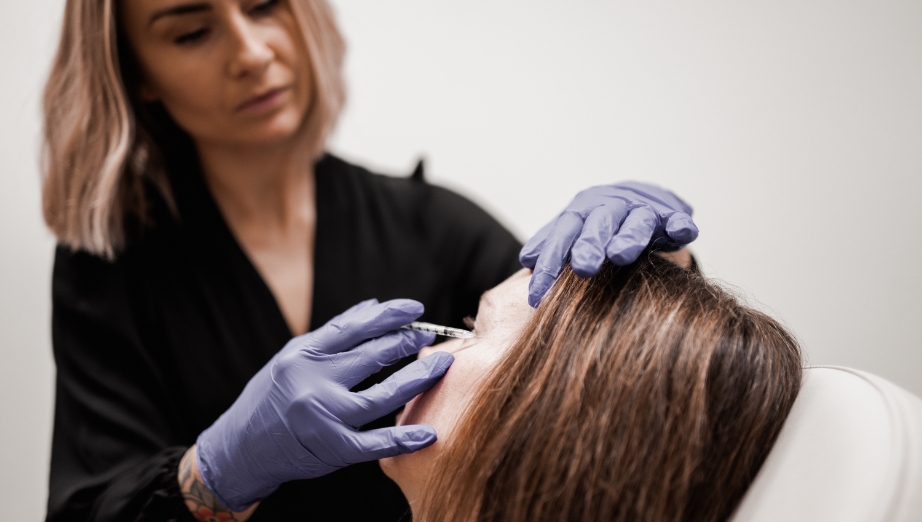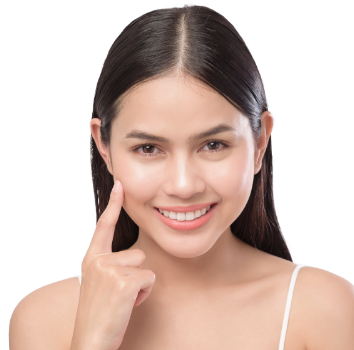Facial lines and wrinkles are a normal part of ageing and expression. They form over time as the skin, muscles, and connective tissues interact.
A Consultation for Fine Lines and Wrinkles at Shellharbour Skin offers an opportunity to understand why these lines occur and to discuss safe, evidence-based approaches under medical supervision.
This consultation is educational in nature, it focuses on explaining facial anatomy, expression-related movement, and the natural changes that occur in the skin with age.
Understanding Expression Lines: Dynamic vs Static
Lines on the face are generally categorised into two groups, dynamic lines and static lines.
Understanding the difference helps explain how facial movement and ageing contribute to visible changes over time.
Dynamic Lines
- These appear only during facial expression, such as smiling, frowning, squinting, or raising the eyebrows.
- They are caused by the repeated contraction of underlying muscles, which fold the skin in specific patterns.
- In younger skin, dynamic lines often disappear once the expression relaxes because of healthy collagen and elasticity.
Over time, as skin resilience decreases, these temporary folds can begin to leave visible creases.
Static Lines
- Static lines are visible even when the face is at rest.
- They develop gradually as dynamic lines become imprinted into the skin’s structure due to loss of collagen, elastin, and hydration.
- Other contributors include sun exposure, sleep position, smoking, and genetic factors.
- These lines reflect long-term structural changes in both the skin and the soft tissues beneath it.
The distinction between dynamic and static lines forms the foundation for clinical discussions about appropriate management strategies, which can range from skin health optimisation to medical approaches that target muscle movement or support collagen production.

Your Consultation at Shellharbour Skin
During your consultation, your clinician will perform a comprehensive facial assessment, focusing on the movement, depth, and distribution of lines across different areas of the face.
This assessment helps to identify whether your lines are primarily dynamic, static, or a combination of both.
Your clinician will:
- Review your medical and treatment history, including allergies, medications, supplements, and previous aesthetic procedures.
- Observe facial movement patterns (e.g., smiling, frowning, raising brows) to understand which muscles are most active.
- Assess the quality of your skin and its elasticity.
- Discuss how facial anatomy, repetitive movement, and skin health contribute to visible lines.
- Explain that some management options may involve a combination of medical treatment or skin treatment such has Laser Genesis, Alma Hybrid, Microneedling
- Explore medical treatment options such as skincare, sun protection, and general lifestyle factors that support long-term skin health.
- Provide time to ask questions and express any concerns.
No procedure is performed during the initial consultation.
If a management plan is appropriate, it is developed only after full assessment and informed consent.
Treatment Approach Discussions
Following assessment, your clinician may outline potential management pathways for you to consider.These discussions are informative only -they are not intended to promote any particular treatment or imply cosmetic results.
Topics may include:
- Observation or monitoring if no intervention is required
- Educational discussion about muscle movement patterns and facial mechanics
- Non-surgical options to support the skin’s structure and integrity
- Information about prescription-only medicines that can influence muscle activity, provided only under medical supervision
- Strategies for maintaining overall skin health and preventing further collagen breakdown
Any subsequent plan is personalised based on your anatomy, health, and preferences, and no pathway proceeds without suitability confirmation and informed consent.
Aftercare and Follow-Up
If you proceed with a management plan, your clinician will provide a personalised aftercare guide.Temporary effects such as redness, swelling, or mild tenderness may occur and typically resolve within days.
General aftercare recommendations may include:
- Avoid strenuous exercise and alcohol for 24 hours
- Do not touch or rub the area
- Remain upright for several hours after the session
- Avoid exposure to heat (saunas, steam, hot yoga) until tenderness resolves
- Delay facials, peels, or skin needling for at least two weeks
- Contact the clinic if you experience unexpected pain, discolouration, or swelling
Follow-up consultations are encouraged to review progress and make any necessary adjustments.
Risks and Considerations
All medical and aesthetic procedures carry potential risks. Your clinician will discuss these comprehensively before any decision.
Common temporary effects:
- Redness or bruising
- Mild swelling or tightness
- Headache or temporary tenderness
Less common or serious effects:
- Localised muscle weakness or asymmetry
- Eyelid or brow heaviness
- Infection or allergic reaction
- Numbness or tingling sensations
- Nausea or fatigue
If you experience persistent discomfort, vision changes, or unexpected pain, seek medical assessment immediately.
Cost and Planning
Consultation fees vary depending on the areas assessed and the complexity of your plan.
Any use of prescription-only medicines can only occur after medical evaluation and approval, with costs outlined transparently during your consultation.
Important Information
- Shellharbour Skin provides educational consultations in accordance with AHPRA and TGA standards.
We do not advertise, name, or promote prescription-only medicines. - All clinical pathways require a face-to-face medical assessment to determine suitability.
- Individual experiences differ, and outcomes cannot be guaranteed.
- This information is for educational purposes only and does not replace personalised medical advice.
Practitioner Transparency
Consultations and skin treatments at Shellharbour Skin are provided by a multidisciplinary clinical team:
Dermal Clinicians – qualified skin professionals who are not registered under AHPRA but hold tertiary qualifications in dermal science or dermal therapies. They provide skin treatments and consultations within their professional scope and under clinical supervision.
Registered Nurses – AHPRA-registered health practitioners who perform skin and aesthetic treatments within their clinical training and scope of practice.
Medical Practitioners – AHPRA-registered doctors experienced in skin health and aesthetic medicine who oversee and support all clinical services.
All treatments are undertaken within a medically supervised environment, ensuring that each patient pathway is reviewed for clinical suitability, safety, and evidence-based care.
You can verify registration for medical practitioners and nurses at ahpra.gov.au
Frequently Asked Questions
What is discussed during fine and wrinkle consultation?
This consultation provides an opportunity to discuss concerns related to facial movement and expression lines. Your clinician will assess your facial anatomy, review your medical history, and explain how certain prescription-only medicines, when administered under medical supervision, may assist in managing the appearance of these lines. The goal of this discussion is to determine whether this approach is appropriate for you.
Who conducts these consultations at Shellharbour Skin?
Consultations are performed by registered medical practitioners and registered nurses who hold appropriate qualifications, training, and authorisation to prescribe or administer prescription-only medicines. Each practitioner’s registration can be verified on the AHPRA website
Who may not be suitable for this treatment?
This treatment may not be suitable for individuals who are pregnant, breastfeeding, or who have specific medical or neuromuscular conditions. Your clinician will review your medical history to confirm suitability before proceeding.
Can this be combined with other treatments?
In some cases, it may be appropriate to combine this approach with other professional skin treatments such as peels, laser, or microneedling. Your clinician will advise on safe and suitable combinations based on your medical assessment.
What is the difference between dynamic and static expression lines?
Dynamic lines appear only when facial muscles move, such as when smiling, frowning, or squinting. Static lines are visible even when the face is at rest and usually develop as collagen and elasticity decrease. Understanding the difference helps clinicians determine whether muscle activity, skin condition, or both contribute to your concerns.
Why is an initial consultation required before treatment?
A consultation ensures that any procedure discussed is safe and appropriate for you.
Your clinician will assess your facial anatomy, review your medical history, and discuss whether a treatment involving prescription-only medicines, if relevant, is suitable. This supports informed consent and patient safety.
Are prescription-only medicines the only option for managing expression lines?
No. Some individuals may explore non-medical options such as professional skincare, laser, or microneedling.Your clinician will discuss various evidence-based approaches based on your goals and assessment.
Are there lifestyle factors that can help prevent deeper lines?
Yes. The development of deeper expression lines is influenced by both natural ageing and environmental factors. Protecting the skin from ultraviolet (UV) exposure through daily use of sunscreen, wearing hats, and seeking shade helps reduce collagen breakdown over time. Maintaining hydration, eating a balanced diet, and getting adequate sleep support the skin’s ability to repair and maintain elasticity. Avoiding smoking is also important, as tobacco exposure is associated with premature skin ageing.
Your clinician may discuss how these factors relate to your individual skin health and provide education on how to incorporate protective habits into your long-term care plan.
What happens if I decide not to proceed after the consultation?
There is no obligation to proceed.Your consultation is designed to help you understand your options. You may choose to defer or decline treatment after reviewing the information.
Are prescription-only products used in these treatments?
Prescription-only medicines can only be discussed or prescribed under the supervision of a qualified medical practitioner following a suitability assessment.Shellharbour Skin does not advertise, name, or promote prescription-only products.
Why aren’t prescription products named on this website?
Australian law prohibits the advertising of Schedule 4 (prescription-only) medicines to the public. For this reason, Shellharbour Skin does not name or promote these products.
Any discussion about prescription medicines occurs only during a private consultation under medical supervision, after a qualified prescriber has assessed your suitability.
If you have a question, get in touch and one of our staff will be in touch shortly.




